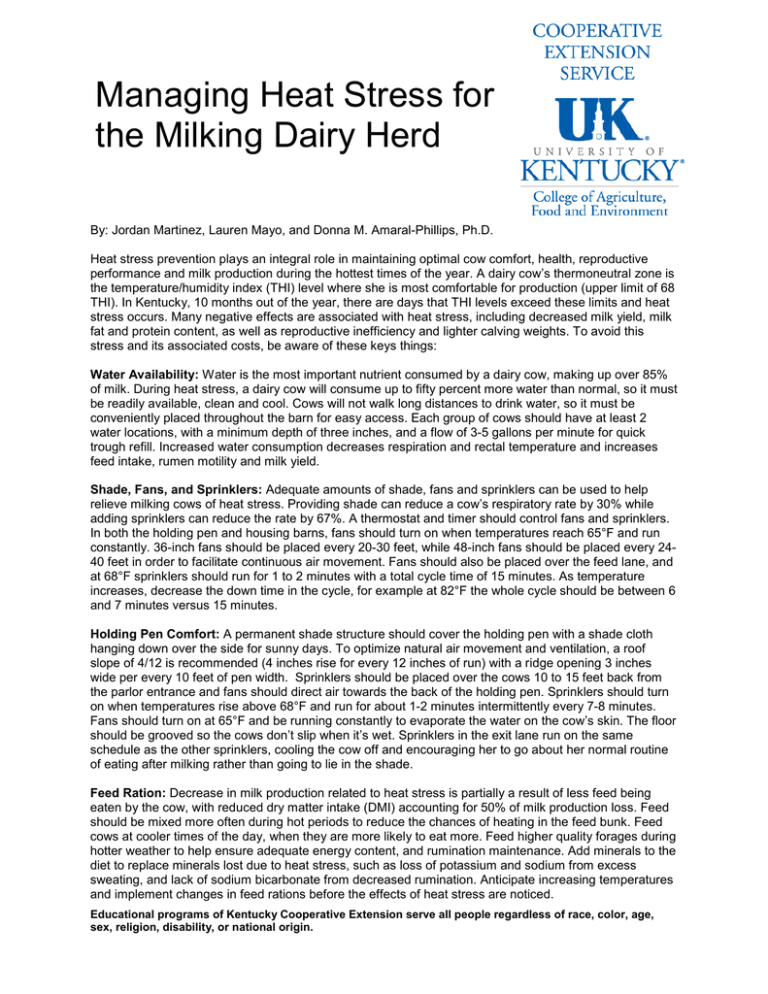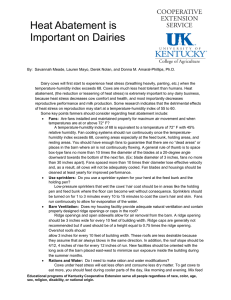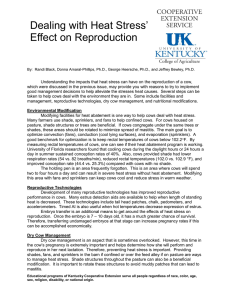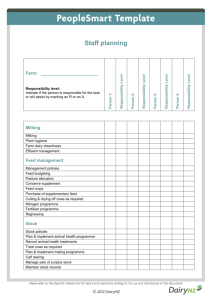Managing Heat Stress for the Milking Dairy Herd
advertisement

Managing Heat Stress for the Milking Dairy Herd By: Jordan Martinez, Lauren Mayo, and Donna M. Amaral-Phillips, Ph.D. Heat stress prevention plays an integral role in maintaining optimal cow comfort, health, reproductive performance and milk production during the hottest times of the year. A dairy cow’s thermoneutral zone is the temperature/humidity index (THI) level where she is most comfortable for production (upper limit of 68 THI). In Kentucky, 10 months out of the year, there are days that THI levels exceed these limits and heat stress occurs. Many negative effects are associated with heat stress, including decreased milk yield, milk fat and protein content, as well as reproductive inefficiency and lighter calving weights. To avoid this stress and its associated costs, be aware of these keys things: Water Availability: Water is the most important nutrient consumed by a dairy cow, making up over 85% of milk. During heat stress, a dairy cow will consume up to fifty percent more water than normal, so it must be readily available, clean and cool. Cows will not walk long distances to drink water, so it must be conveniently placed throughout the barn for easy access. Each group of cows should have at least 2 water locations, with a minimum depth of three inches, and a flow of 3-5 gallons per minute for quick trough refill. Increased water consumption decreases respiration and rectal temperature and increases feed intake, rumen motility and milk yield. Shade, Fans, and Sprinklers: Adequate amounts of shade, fans and sprinklers can be used to help relieve milking cows of heat stress. Providing shade can reduce a cow’s respiratory rate by 30% while adding sprinklers can reduce the rate by 67%. A thermostat and timer should control fans and sprinklers. In both the holding pen and housing barns, fans should turn on when temperatures reach 65°F and run constantly. 36-inch fans should be placed every 20-30 feet, while 48-inch fans should be placed every 2440 feet in order to facilitate continuous air movement. Fans should also be placed over the feed lane, and at 68°F sprinklers should run for 1 to 2 minutes with a total cycle time of 15 minutes. As temperature increases, decrease the down time in the cycle, for example at 82°F the whole cycle should be between 6 and 7 minutes versus 15 minutes. Holding Pen Comfort: A permanent shade structure should cover the holding pen with a shade cloth hanging down over the side for sunny days. To optimize natural air movement and ventilation, a roof slope of 4/12 is recommended (4 inches rise for every 12 inches of run) with a ridge opening 3 inches wide per every 10 feet of pen width. Sprinklers should be placed over the cows 10 to 15 feet back from the parlor entrance and fans should direct air towards the back of the holding pen. Sprinklers should turn on when temperatures rise above 68°F and run for about 1-2 minutes intermittently every 7-8 minutes. Fans should turn on at 65°F and be running constantly to evaporate the water on the cow’s skin. The floor should be grooved so the cows don’t slip when it’s wet. Sprinklers in the exit lane run on the same schedule as the other sprinklers, cooling the cow off and encouraging her to go about her normal routine of eating after milking rather than going to lie in the shade. Feed Ration: Decrease in milk production related to heat stress is partially a result of less feed being eaten by the cow, with reduced dry matter intake (DMI) accounting for 50% of milk production loss. Feed should be mixed more often during hot periods to reduce the chances of heating in the feed bunk. Feed cows at cooler times of the day, when they are more likely to eat more. Feed higher quality forages during hotter weather to help ensure adequate energy content, and rumination maintenance. Add minerals to the diet to replace minerals lost due to heat stress, such as loss of potassium and sodium from excess sweating, and lack of sodium bicarbonate from decreased rumination. Anticipate increasing temperatures and implement changes in feed rations before the effects of heat stress are noticed. Educational programs of Kentucky Cooperative Extension serve all people regardless of race, color, age, sex, religion, disability, or national origin.






